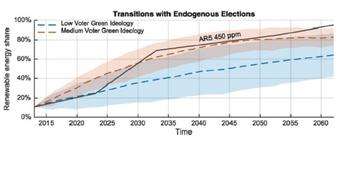Accounting for politics in green energy transitions

Politics plays a hand in how, and whether, a nation transitions to renewable energy. But despite the significant effects of policy on technological progress, few growth projections for renewables take political dynamics into account.
A new computational model by SFI Omidyar Fellow Marion Dumas and colleagues adds a layer of complexity to the existing models, by forecasting 50-year carbon emissions under differing political scenarios.
"Models that try to understand the dynamics of these [energy] technologies don't incorporate political competition," Dumas explains, "but political competition interacts with the technology's dynamics. Certain actions taken today will affect the actions possible in the future."
The researcher's model frames empirical data on technological progression in the context of two competing political parties鈥攁 "green party" and the "brown party" with differing degrees of commitment to their constituents. Among other findings, their model shows that winning an election early on has significantly greater impact on the 50-year trajectory than a later win, and a strong commitment from one party can force the less committed party to compromise.
The article, published in Ecological Economics, overlays 50-year political scenarios onto the 450 ppm carbon limit set by the Intergovernmental Panel for Climate Change (IPCC). According to Dumas, the United States is "still far from a situation where the green party is driving the dynamic, and supports a committed electorate. That's what's needed to avoid overshooting the IPCC's limit."
More information: Marion Dumas et al. Political competition and renewable energy transitions over long time horizons: A dynamic approach, Ecological Economics (2016).
Provided by Santa Fe Institute


















